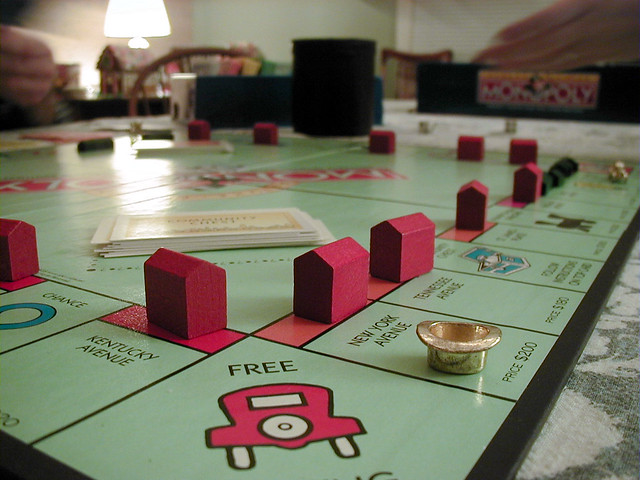 |
| All rights (c) Hasbro. |
1) Goal(s).Usually easy for educational games.
But wait... maybe not. Teachers are used to setting objectives, but the kind of objective makes a big difference in the game. If in addition to content objectives, the teacher has process objectives, it can make a big difference in the game. The good news for mathies is that any game with strategy feels like it's connecting to the problem solving process.
2) Rules.Rules need to be understandable, but make things hard enough for the player. I think some ed games have trouble here, because of the old saw about about good teachers make things easy for their students. Goes well, however, with the resurgence of the 'be less helpful' mode of teaching. (We can't call it new if Dewey was onto it.)
3) Interaction.The game has to help what players do matter to each other. This is a major failing of Jeopardy and Bingo and Baseball, etc. where competition is the only interaction. Probably this is the best aspect of my most recent game Card Catch, with Nick Smith. Players set the goal for each other, and the longer the game goes on, the more information you have about your opponents' cards, which adds a whole second level of strategy and math.
4) Catch-Up.If a player who falls behind has no chance, it disengages them. I just recently noticed how much this matters to me. I think because as a game lover, this is one of the few things I loathe about them. Think about the slow grinding Monopoly death... (shudder) Within the game, players need to be able to catch up. It doesn't have to be likely - then it's Candy Land, where you can't keep a lead. You might as well be teleporting around that board. It does have to be possible, which will help create stories of the epic win.
In educational games this is a double danger, since so many ed games reward players who've already learned the material. If a math game is about who's fastest, there are students who start the game knowing there's no hope. Sometimes this is an easy fix by adding a bit of chance, but usually it requires structural design. I think this principle is why so many games get pushed to review in the classroom, instead of being used to help learn.

5) Inertia.Leave them wanting more. Get out while the getting's good. Dave Coffey is excellent at this with his lessons, always leaving students something to think about on the way home. I measure this by whether students are 'whew' or 'ohhhhh' when our time is up. In my experience this connects heavily with (2), Rules. Too easy or too hard shows up here.
Mark connects it with writing advice: make it as short as you can, then cut 10%.
Also tough for teachers, because we're trained to go until everyone finishes. Much better to have people sitting around doing nothing (quietly, of course) than to have anyone not have a chance to finish. That's murder to a game.
So Far So Good
I'd be really interested in hearing other people's ideas about this. Not sure where the best venue is ... maybe the Linked In game based learning group?
If his list next week is as good as this week's look for my part 2 next Monday! I'm enjoying wondering what the next five things must be...
It was 2 weeks! My 2nd part is up, with links to Mark's 2nd part.
Image credits: Usonian, Kathy Cassidy @ Flickr

Tidak ada komentar:
Posting Komentar